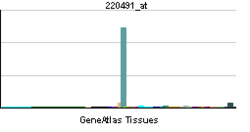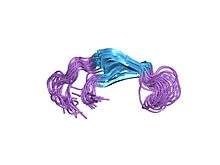HAMP
| View/Edit Human | |||
Hepcidin is a protein that in humans is encoded by the HAMP gene.[2][3][4]
The product encoded by this gene is involved in the maintenance of iron homeostasis, and it is necessary for the regulation of iron storage in macrophages, and for intestinal iron absorption. The preproprotein is post-translationally cleaved into mature peptides of 20, 22 and 25 amino acids, and these active peptides are rich in cysteines, which form intramolecular bonds that stabilize their beta sheet structures. These peptides exhibit antimicrobial activity. Mutations in this gene cause hemochromatosis type 2B, also known as juvenile hemochromatosis, a disease caused by severe iron overload that results in cardiomyopathy, cirrhosis, and endocrine failure.[4]
See also
References
- ↑ "Human PubMed Reference:".
- ↑ Krause A, Neitz S, Magert HJ, Schulz A, Forssmann WG, Schulz-Knappe P, Adermann K (Nov 2000). "LEAP-1, a novel highly disulfide-bonded human peptide, exhibits antimicrobial activity". FEBS Lett. 480 (2–3): 147–50. doi:10.1016/S0014-5793(00)01920-7. PMID 11034317.
- ↑ Pigeon C, Ilyin G, Courselaud B, Leroyer P, Turlin B, Brissot P, Loreal O (May 2001). "A new mouse liver-specific gene, encoding a protein homologous to human antimicrobial peptide hepcidin, is overexpressed during iron overload". J Biol Chem. 276 (11): 7811–9. doi:10.1074/jbc.M008923200. PMID 11113132.
- 1 2 "Entrez Gene: HAMP hepcidin antimicrobial peptide".
Further reading
- Ganz T (2003). "Hepcidin, a key regulator of iron metabolism and mediator of anemia of inflammation". Blood. 102 (3): 783–8. doi:10.1182/blood-2003-03-0672. PMID 12663437.
- Roy CN, Andrews NC (2005). "Anemia of inflammation: the hepcidin link". Curr. Opin. Hematol. 12 (2): 107–11. doi:10.1097/00062752-200503000-00001. PMID 15725899.
- Fleming RE, Britton RS, Waheed A, et al. (2006). "Pathophysiology of hereditary hemochromatosis". Semin. Liver Dis. 25 (4): 411–9. doi:10.1055/s-2005-923313. PMC 2587012
 . PMID 16315135.
. PMID 16315135. - Park CH, Valore EV, Waring AJ, Ganz T (2001). "Hepcidin, a urinary antimicrobial peptide synthesized in the liver". J. Biol. Chem. 276 (11): 7806–10. doi:10.1074/jbc.M008922200. PMID 11113131.
- Majore S, Binni F, Ricerca BM, et al. (2002). "Absence of hepcidin gene mutations in 10 Italian patients with primary iron overload". Haematologica. 87 (2): 221–2. PMID 11836175.
- Klüver E, Schulz A, Forssmann WG, Adermann K (2002). "Chemical synthesis of beta-defensins and LEAP-1/hepcidin". J. Pept. Res. 59 (6): 241–8. doi:10.1034/j.1399-3011.2002.00980.x. PMID 12010514.
- Hunter HN, Fulton DB, Ganz T, Vogel HJ (2002). "The solution structure of human hepcidin, a peptide hormone with antimicrobial activity that is involved in iron uptake and hereditary hemochromatosis". J. Biol. Chem. 277 (40): 37597–603. doi:10.1074/jbc.M205305200. PMID 12138110.
- Weinstein DA, Roy CN, Fleming MD, et al. (2003). "Inappropriate expression of hepcidin is associated with iron refractory anemia: implications for the anemia of chronic disease". Blood. 100 (10): 3776–81. doi:10.1182/blood-2002-04-1260. PMID 12393428.
- Nemeth E, Valore EV, Territo M, et al. (2003). "Hepcidin, a putative mediator of anemia of inflammation, is a type II acute-phase protein". Blood. 101 (7): 2461–3. doi:10.1182/blood-2002-10-3235. PMID 12433676.
- Roetto A, Papanikolaou G, Politou M, et al. (2003). "Mutant antimicrobial peptide hepcidin is associated with severe juvenile hemochromatosis". Nat. Genet. 33 (1): 21–2. doi:10.1038/ng1053. PMID 12469120.
- Strausberg RL, Feingold EA, Grouse LH, et al. (2003). "Generation and initial analysis of more than 15,000 full-length human and mouse cDNA sequences". Proc. Natl. Acad. Sci. U.S.A. 99 (26): 16899–903. doi:10.1073/pnas.242603899. PMC 139241
 . PMID 12477932.
. PMID 12477932. - Gehrke SG, Kulaksiz H, Herrmann T, et al. (2003). "Expression of hepcidin in hereditary hemochromatosis: evidence for a regulation in response to the serum transferrin saturation and to non-transferrin-bound iron". Blood. 102 (1): 371–6. doi:10.1182/blood-2002-11-3610. PMID 12637325.
- Merryweather-Clarke AT, Cadet E, Bomford A, et al. (2004). "Digenic inheritance of mutations in HAMP and HFE results in different types of haemochromatosis". Hum. Mol. Genet. 12 (17): 2241–7. doi:10.1093/hmg/ddg225. PMID 12915468.
- Clark HF, Gurney AL, Abaya E, et al. (2003). "The secreted protein discovery initiative (SPDI), a large-scale effort to identify novel human secreted and transmembrane proteins: a bioinformatics assessment". Genome Res. 13 (10): 2265–70. doi:10.1101/gr.1293003. PMC 403697
 . PMID 12975309.
. PMID 12975309. - Roetto A, Daraio F, Porporato P, et al. (2004). "Screening hepcidin for mutations in juvenile hemochromatosis: identification of a new mutation (C70R)". Blood. 103 (6): 2407–9. doi:10.1182/blood-2003-10-3390. PMID 14630809.
- Jacolot S, Le Gac G, Scotet V, et al. (2004). "HAMP as a modifier gene that increases the phenotypic expression of the HFE pC282Y homozygous genotype". Blood. 103 (7): 2835–40. doi:10.1182/blood-2003-10-3366. PMID 14670915.
- Ota T, Suzuki Y, Nishikawa T, et al. (2004). "Complete sequencing and characterization of 21,243 full-length human cDNAs". Nat. Genet. 36 (1): 40–5. doi:10.1038/ng1285. PMID 14702039.
External links
This article incorporates text from the United States National Library of Medicine, which is in the public domain.


